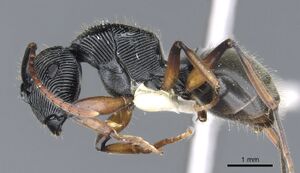Polyrhachis roomi
| Polyrhachis roomi | |
|---|---|

| |
| Scientific classification | |
| Kingdom: | Animalia |
| Phylum: | Arthropoda |
| Class: | Insecta |
| Order: | Hymenoptera |
| Family: | Formicidae |
| Subfamily: | Formicinae |
| Tribe: | Camponotini |
| Genus: | Polyrhachis |
| Subgenus: | Aulacomyrma |
| Species: | P. roomi |
| Binomial name | |
| Polyrhachis roomi Kohout, 2007 | |
Nothing is known about the biology of Polyrhachis roomi.
Identification
Kohout (2007) - This species is easily recognisable by its relatively large size.
Keys including this Species
Distribution
Distribution based on Regional Taxon Lists
Indo-Australian Region: New Guinea (type locality).
Distribution based on AntMaps
Distribution based on AntWeb specimens
Check data from AntWeb
Countries Occupied
| Number of countries occupied by this species based on AntWiki Regional Taxon Lists. In general, fewer countries occupied indicates a narrower range, while more countries indicates a more widespread species. |

|
Estimated Abundance
| Relative abundance based on number of AntMaps records per species (this species within the purple bar). Fewer records (to the left) indicates a less abundant/encountered species while more records (to the right) indicates more abundant/encountered species. |

|
Biology
|
Castes
Known only from the worker caste.
Images from AntWeb

| |
| Worker. Specimen code casent0009234. Photographer April Nobile, uploaded by California Academy of Sciences. | Owned by ANIC, Canberra, Australia. |
   
| |
| Paratype of Polyrhachis roomi. Worker. Specimen code casent0903322. Photographer Z. Lieberman, uploaded by California Academy of Sciences. | Owned by NHMUK, London, UK. |
Nomenclature
The following information is derived from Barry Bolton's Online Catalogue of the Ants of the World.
- roomi. Polyrhachis (Aulacomyrma) roomi Kohout, 2007a: 236, figs. 100, 103, 106 (w.) NEW GUINEA.
Unless otherwise noted the text for the remainder of this section is reported from the publication that includes the original description.
Description
Worker
TL c. 6.05-6.60 (6.60); HL 1.50-1.72 (1.56); HW 1.28-1.50 (1.34); CI 85-88 (86); SL 1.56-1.72 (1.59); SI 115-126 (119); PW 1.03-1.18 (1.06); MTL 1.53-1.68 (1.59) (5 measured).
Anterior clypeal margin distinctly emarginate medially, dentate on each side of emargination; clypeus with weakly raised longitudinal carina, almost straight in profile; basal margin weakly impressed and indicated laterally by faint line breaking cephalic sculpture. Frontal carinae with strongly sinuate and distinctly raised laminate lobes. Sides of head convex. Eyes virtually flat, situated well forward on sides of head; inner margins somewhat sunk into shallow concavity in cephalic sculpture; not or only just reaching lateral cephalic outline in full face view. Mesosoma with pronotal and propodeal dorsa laterally immarginate; mesonotal dorsum with outermost striae forming short margin. Pronotal humeri armed with short, laterally and anteriorly directed, horizontal spines. Promesonotal suture rather shallow, indicated by change in direction of sculpture; metanotal groove lacking. Propodeal dorsum separated from declivity by faint posterior border that, viewed from behind, forms inverse ‘V’ terminating laterally in small denticles. Dorsal petiolar margin with pair of acute intercalary teeth medially, shallowly emarginate between them; laterally margin somewhat jagged, lateral teeth acute, weakly upturned. Anterior face of first gastral segment shallowly concave, narrowly rounding onto dorsum of segment.
Mandibles densely, rather finely, longitudinally striate. Dorsum of head with mostly regular striae; longitudinal and anteriorly converging on clypeus, obliquely curving from sides of head towards basal clypeal margin, transverse and anteriorly bowed on vertex with outermost striae converging towards central area between frontal carinae. Pronotal dorsum mostly regularly, transversely striate; striae curving vertically onto sides. Striae on mesonotal-propodeal dorsum transverse, bowed posteriorly into open U-shapes; sides with striae more-or-less horizontal. Petiole and gaster finely shagreened.
Dorsum of head and mesosoma with medium length, mostly erect, off-white or yellowish hairs; hairs somewhat posteriorly curved and golden on gastral dorsum, distinctly longer along sternites and on gastral apex. Appressed pubescence much reduced on head and mesosomal dorsum, only patches of sparse, off-white or silvery pubescence on sides of propodeum, along propodeal declivity, petiole and coxae. Golden and rather dense gastral pubecence mostly confined to dorsum of first segment, not completely concealing underlying sculpture.
Black; most of antennal scapes, basal half of first funicular segment, joints of femora and tibiae, bases of basal tarsal segments and gaster dark to very dark reddish-brown. Mandibular masticatory border, basal and distal ends of antennal scapes, funiculi and most of legs light to very light reddish-yellow.
Type Material
HOLOTYPE: PAPUA NEW GUINEA, Northern Prov., Sangara, 18.xii.1971, P. M. Room (worker). PARATYPES: data as for holotype (4 workers). Type distribution: holotype in Australian National Insect Collection, 1 paratype each in The Natural History Museum, California Academy of Sciences, Museum of Comparative Zoology and Queensland Museum.
Etymology
Named in honour of the collector, Dr Peter M. Room of CSIRO, Division of Entomology, Indooroopilly, Queensland, Australia, who collected scores of ants, many new to science, during the years of his appointment as an agricultural entomologist in Papua New Guinea.
References
References based on Global Ant Biodiversity Informatics
- Janda M., G. D. Alpert, M. L. Borowiec, E. P. Economo, P. Klimes, E. Sarnat, and S. O. Shattuck. 2011. Cheklist of ants described and recorded from New Guinea and associated islands. Available on http://www.newguineants.org/. Accessed on 24th Feb. 2011.
- Kohout R.J. 2007. Revision of the subgenus Aulacomyrma Emery of the genus Polyrhachis F. Smith, with descriptions of new species (pp. 186-253). In Snelling, R.R., Fisher, B.L. & Ward, P.S. (eds). Advances in ant systematics: homage to E.O. Wilson 50 years of contributions. Memoirs of the American Entomological Institute 80: 690 pp.

